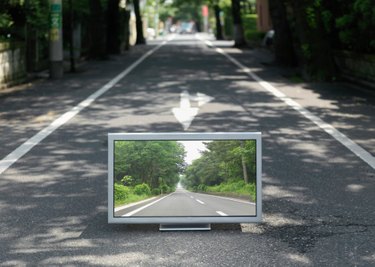
Your television can display blurred lines for a variety of reasons. Problems that can affect the TV and create blurred lines include an error on the part of your cable or satellite company, a loose coaxial cable in your receiver, a damaged audio/video cable, and electronic interference from powerful external devices. You can diagnose, troubleshoot and repair all of these problems and fix your TV even if you have never attempted such repairs before.
Step 1
Power off both the TV and your cable or satellite receiver box. Allow the TV to cool down for several minutes while the receiver reboots. Turn the TV back on. This simple process may prove to fix the blurred lines on your display.
Video of the Day
Step 2
Observe different channels on your TV. Use the remote control to flip through several channels and examine the on-screen effect. If some of the channels on your TV are affected by the blurriness but not others, you will need to contact your satellite or cable provider and provide them with this information. The blurriness is an error on their end and is unrelated to your TV and its display.
Step 3
Adjust the black, single-pronged coaxial cable that plugs into the rear "Ant In" port on your cable or satellite receiver box. If this cable is loose, you will need to tighten it. A loose coaxial cable will create static and "noise" on the screen that can cause blurriness. Tighten the cable by pinching and twisting the metal band on its cable end to the right. Continue pinching and twisting until you can tighten the cable no further. This will remove the static from the screen and should get rid of the blurred line effect.
Step 4
Observe the audio/video cable that connects the cable or satellite receiver. Ensure that the black cord is not damaged and that none of the prongs on the end of the A/V cable are bent or compromised in any way. If the cable is damaged, be sure to immediately replace it.
Step 5
Consider the possibility of harmful interference affecting your television's display. Electronic devices that drain and use a lot of power can also give off a lot of electronic interference. Speakers and computers are examples of such potential devices. If these kinds of electronics are too close to your TV's display, the screen will be adversely affected and blurred lines and other general blurriness will occur. Move any powerful electronic devices further away from your TV.
Video of the Day